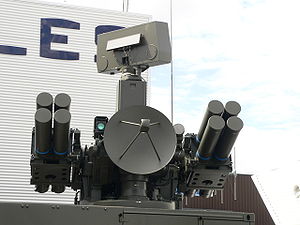|
Crotale (missile)
 The Crotale (English: "Pit Viper" or "Rattlesnake") is a French, all-weather, short-range surface-to-air missile system developed to intercept airborne ranged weapons and aircraft, from cruise or anti-ship missiles to helicopters, UAVs or low-flying high-performance fighter aircraft. It was developed by Thomson CSF Matra (now Thales Group) and consists of a mobile land-based variant as well as various naval ones. DevelopmentOriginally the Crotale R440 system was developed by Rockwell International and Thomson-Houston (and Mistral) in France for South Africa, where it was named Cactus. However, the achievements of the system impressed the French Armed Forces, who purchased the system both for the air force and for the navy. The French Air Force utilized a 4x4 wheeled vehicle developed by Hotchkiss et Cie, the P4R, armed with four missiles. A more mobile system to protect ground forces was mounted on the chassis of the French AMX-30 main battle tank. This was adopted with a larger and more capable missile by Saudi Arabia as Shahine. At the same time, the number of launchers was increased to six. In Finnish Army service, the Crotale NG system has been mounted on Sisu Pasi vehicles. Here the number of launchers is eight. The Crotale system has also been installed on various military ships. For instance, the French Navy La Fayette-class frigates have a Crotale 8-tubed launcher near the helicopter flight deck. The firing system includes the main sensors of the ship, the firing system of the turret, and a central coordination system. The turret holds eight missiles ready for launch in watertight containers. The magazine behind the turret holds 18 missiles. The automatic command to line-of-sight guidance system uses both radar and IRST to locate a target and to track it and the missile.[3] Crotale NGA modernized version, the Crotale NG (New Generation), entered production in 1990. This version used the new VT-1 missile with Mach 3.5 speed, load factor to 35G, 11 km range, 13 kg warhead (8 m kill-zone) and 6,000 m ceiling. The system includes a S-band Pulse Doppler radar (20 km), Ku-band TWT tracking radar (30 km), Thermal camera (19 km), Daylight CCD camera (15 km), and an IR localiser.[4] An early '90s proposal to fit the system (in its eight-round form) to a Leclerc tank chassis in order to provide a battlefield air defence vehicle for protecting armored formations on the move was not realised due to post-Cold War cutbacks. K-SAM PegasusIn 1999, the Republic of Korea Armed Forces awarded a contract to Samsung and Thales to jointly develop a South Korean-augmented Crotale NG system for the K-SAM Pegasus short-range air defense system. A new sensor system was jointly developed by Samsung and Thales to meet the required operational capability of the upcoming K-SAM Pegasus,[5] as well as a new indigenous missile by LIG Nex1.[6] The electronics and radars were developed by Samsung Electronics.[7] Doosan DST integrated this modified Crotale NG system with a K200 vehicle. 48 units were initially produced for a price-tag of 330 million Euros.[8] A second batch of 66 units was ordered in 2003, valued at 470 million Euros. Multi-Shield 100Thales revealed an updated Crotale NG system with Shikra radar at the Paris Air Show in 2007.[9] The system combines Crotale Mk3 VT-1 missile and Shikra multi-beam search radar, with 150 km (detection range). Thales has demonstrated that the system's VT-1 missile has extended range to 15 km.[10] TechnologyThe Crotale missile system consists of two components; a vehicle for transport, equipped with 2-8 launchers; a tracking radar located between the launchers. A second vehicle carries the surveillance radar. The radar surveillance vehicle can be connected to several launcher vehicles, in order to achieve an effective air-defence system. The Crotale NG has incorporated both the launcher and the surveillance radar in one vehicle. The missile is propelled by a solid-propellant rocket motor and can accelerate to a maximum speed of Mach 2.3 in two seconds. The missile is sent guidance commands by the base unit directing keeping it on the line of sight until its infrared proximity fuze senses that it is near its target and explodes. The surveillance radar and fire direction radar have a range of 20 km and the TV link works up to 15 km. The TV guidance system uses both regular and infrared cameras. The system can follow 8 targets simultaneously, and the guidance radar can follow both hovering helicopters as well as fighters exceeding Mach 2. The Crotale can also use surveillance data from other systems, data from optical surveillance and from the general aerial picture from the national air defence communications system. Variants   
Operators Current operators
Former operators
See also
References
|
||||||||||||||||||||||||||||||||||||||||||||||||||||||||
